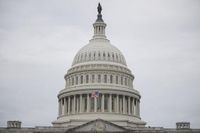Indiana’s political landscape is bracing for a turbulent December as state lawmakers prepare to revisit the contentious issue of congressional redistricting. After weeks of public pressure, private negotiations, and even threats, Indiana’s legislative leaders have set a course for a rare mid-cycle attempt to redraw the state’s U.S. House map—an effort closely watched by both state and national political figures, not least former President Donald Trump.
On November 26, 2025, Indiana Senate President Pro Tem Rodric Bray made headlines by announcing that the Senate would meet the week of December 8 to consider any redistricting proposal sent by the House. This move marked a dramatic reversal. Just days earlier, Bray had insisted there was insufficient Republican support to justify reconvening, and the Senate had voted to delay any redistricting discussion until the regular 2026 session. But mounting pressure from Trump, Governor Mike Braun, and party activists changed the calculus.
“The issue of redrawing Indiana’s congressional maps mid-cycle has received a lot of attention and is causing strife here in our state,” Bray said in a statement, as reported by Indianapolis Star. “To resolve this issue, the Senate intends to reconvene as part of the regular 2026 session on Dec. 8 and make a final decision that week on any redistricting proposal sent from the House.”
Bray’s decision followed an announcement from House Speaker Todd Huston that the House would meet on December 1 to consider all legislative business, including redrawing the state’s congressional map. “Because session will start early this year, we plan to adjust the calendar and complete our legislative business by the end of February,” Huston stated, according to NBC News.
The political stakes are high. The current map, drawn after the 2020 Census, gives Republicans a 7-2 advantage in Indiana’s nine-member U.S. House delegation. Trump and his allies have been pushing for a new map that could eliminate the state’s two remaining Democratic-held seats—those of Reps. André Carson and Frank Mrvan—potentially handing the GOP a 9-0 sweep. Trump’s involvement has been anything but subtle. On his social media platform, Truth Social, he wrote, “It looks like the Indiana Senate Republicans will be coming back in two weeks to take up Redistricting, a very important initiative.” He added a warning: “If they do, I will make sure that all of those people supporting me win their Primaries, and go on to Greatness but, if they don’t, I will partner with the incredibly powerful MAGA Grassroots Republicans to elect STRONG Republicans who are ready to do what is needed to protect our Country and, MAKE AMERICA GREAT AGAIN!”
Governor Mike Braun, who called for a special session in October after months of pressure from the White House, echoed Trump’s threats. According to Indianapolis Star, Braun said he would back Trump’s effort to “recruit, endorse, and finance primary challengers for Indiana’s senators who refuse to support” a new congressional map. “Hoosiers deserve to have fair representation in Washington and now the General Assembly needs to deliver a 9-0 map which will help level the playing field,” Braun posted on X.
The pressure campaign has not been limited to political rhetoric. The environment has grown increasingly hostile, with at least seven state senators receiving violent threats—including swatting incidents, where false reports prompt emergency police responses—since the start of the 2026 legislative session on November 18. Even Governor Braun and a Democratic city councilor have been targeted, illustrating the intensity of the battle. State Senator Greg Goode, who was specifically targeted by Trump’s redistricting push, was among those swatted, as noted by NBC News.
Outside groups have also jumped into the fray, pouring resources into advertising and advocacy efforts to sway lawmakers. Club For Growth and newly formed nonprofits have been particularly active, hoping to tip the balance in favor of redistricting. Meanwhile, the threat of primary challenges looms large. Trump’s call for such challenges has already borne fruit, with at least one Republican challenger emerging in state Sen. Spencer Deery’s West Lafayette district. However, only a handful of senators are actually up for reelection in 2026, meaning the immediate political risk is limited for some lawmakers.
Despite the pressure, Bray has tried to strike a measured tone. “I have a deep and abiding regard for this institution and our democratic process, and that’s a result of my grandfather, my father and my family,” Bray told reporters, as reported by Indiana Capital Chronicle. “I always want to treat it with the utmost respect, which is what I’m trying to do here.”
Bray’s own political pedigree is notable. He succeeded his father, Richard Bray, in the Senate seat, and his grandfather, William Bray, served 24 years in the U.S. House. Since first being elected to the Senate in 2012, Bray has risen quickly, becoming president pro tem in 2018. He was reelected in 2024 for a term running until November 2028, representing a heavily Republican district in central Indiana.
Bray has weathered political storms before. In 2022, he survived a leadership challenge after removing then-Sen. Mark Messmer from a key post over disagreements on an abortion ban bill. This year, he fended off a primary challenger, winning with 63% of the vote. But the current redistricting battle, fueled by Trump’s direct involvement, is arguably his greatest test yet.
The upcoming session will be closely watched not just in Indiana, but nationally. Texas set off a wave of midcycle redistricting earlier this year, and battles over congressional maps have erupted in Missouri, North Carolina, and California. The U.S. Supreme Court is now reviewing a challenge to Texas’s new map, and the Justice Department has joined a Republican-led lawsuit against a Democratic-drawn map in California.
Democrats in Indiana have voiced strong opposition to the redistricting push. House Minority Leader Phil GiaQuinta of Fort Wayne said, “Hoosiers have already said loud and clear that they don’t want redistricting. Why are we wasting valuable time and resources on this when we could be lowering costs for Hoosiers?”
As the December sessions approach, one thing is clear: the outcome will have profound consequences for Indiana’s political future and could serve as a bellwether for similar fights across the country. Lawmakers face not only the challenge of navigating partisan demands, but also ensuring the safety and integrity of the democratic process itself.
With the General Assembly planning to wrap up by the end of February, all eyes are on Indianapolis to see whether the Senate will bow to pressure or hold firm. The answer could reshape the state’s representation in Washington for years to come.






